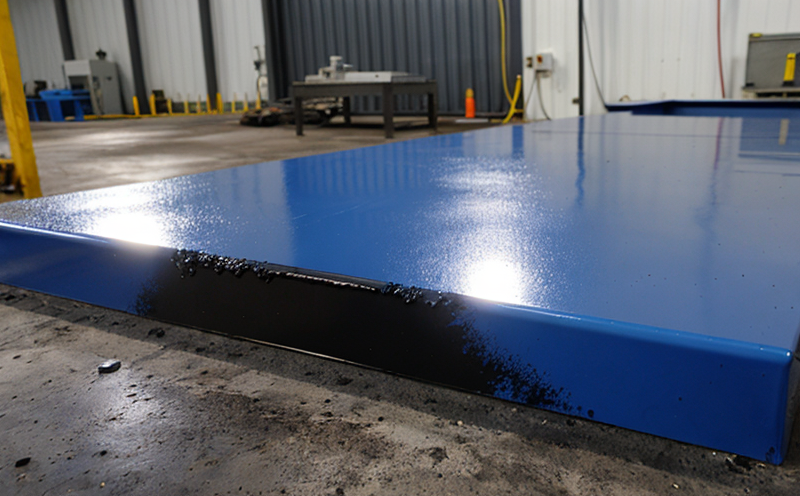ISO 2177 Coulometric Measurement of Metallic Coating Thickness
The ISO 2177 standard provides a method for determining the thickness of metallic coatings by using coulometric titration. This technique is widely used in various sectors, including metallurgy and material testing, to ensure compliance with quality standards and to verify the integrity of protective or decorative layers.
In this process, an electric current is passed through a specimen containing the coating under test, resulting in the dissolution of the metal from the coating. The amount of charge required for complete dissolution is measured electrochemically. From this measurement, the thickness of the metallic layer can be calculated using known constants and empirical formulas.
One of the key advantages of ISO 2177 is its accuracy and repeatability. It allows for precise determination of coating thickness down to submicron levels, which is crucial in industries where even slight variations could lead to significant performance issues or failures. This method ensures that coatings meet specified requirements, enhancing product reliability and safety.
The procedure involves several steps: preparation of the specimen, conditioning, placement into the testing apparatus, application of the current, measurement of charge, calculation of thickness, and final reporting. The specimen must be clean and free from contaminants to ensure accurate results.
Compliance with ISO 2177 is essential for quality managers, compliance officers, and R&D engineers involved in coating production or quality control. It ensures that the products meet specified thickness requirements, which are critical for performance and longevity of materials.
The method's accuracy also supports procurement decisions by providing reliable data on the quality of incoming materials. This can help prevent costly rework or product recalls due to non-compliance with specifications.
Understanding the nuances of this technique is crucial for those involved in metallurgy and material testing, as it directly impacts the performance and reliability of products across various industries such as automotive, aerospace, electronics, and manufacturing.
Scope and Methodology
The scope of ISO 2177 is limited to determining the thickness of metallic coatings by coulometric titration. The methodology involves placing a specimen containing the coating under test into an electrolytic cell where it is exposed to a controlled current. The dissolution of metal from the coating results in the passage of charge, which is measured electrochemically.
The process begins with the preparation and conditioning of the specimen. This step ensures that any surface contaminants are removed and that the coating adheres well to the substrate. Once prepared, the specimen is placed into a cell containing an electrolyte solution. A constant current is then applied for a specified time period, causing the dissolution of metal from the coating.
The charge passed during this process is measured using a coulometer, and the thickness of the metallic layer can be calculated based on the amount of charge used to dissolve the metal. This calculation takes into account the known density of the metal and its atomic weight.
It's important to note that ISO 2177 applies specifically to coatings where the thickness is critical for performance, such as protective layers in corrosion-resistant parts or decorative finishes on consumer products. The standard does not apply to organic coatings or other types of surface treatments.
Benefits
The ISO 2177 coulometric measurement method offers several advantages that make it a preferred choice for testing metallic coating thicknesses:
- Precision and Accuracy: The technique provides highly accurate measurements, ensuring that coatings meet specified thickness requirements. This precision is critical in industries where even small deviations can lead to performance issues or failures.
- Repeatability: ISO 2177 ensures consistent results across multiple tests, making it ideal for quality control and compliance purposes. This repeatability enhances the reliability of the testing process.
- Non-Destructive Testing: The method allows for non-destructive evaluation of coatings, enabling repeated measurements without compromising the integrity of the specimen. This is particularly beneficial in industries where the coating plays a crucial role in product performance and safety.
- Standardization: Adhering to ISO 2177 ensures that testing results are consistent across different laboratories and jurisdictions, facilitating international trade and collaboration.
- Cost-Effective: By ensuring compliance with thickness specifications early in the production process, ISO 2177 helps avoid costly rework or product recalls. This reduces overall costs associated with non-compliant products.
The benefits of ISO 2177 extend beyond just meeting regulatory requirements; they contribute to enhancing the quality and reliability of products across various industries. By ensuring that coatings meet specified thickness requirements, this method supports innovation in product design and manufacturing processes.
Competitive Advantage and Market Impact
The implementation of ISO 2177 coulometric measurement can provide significant competitive advantages and market impact for companies operating in the metallurgy and material testing sector. By ensuring that coatings meet specified thickness requirements, businesses can enhance product reliability and safety, which is crucial in industries such as automotive, aerospace, electronics, and manufacturing.
Compliance with this standard demonstrates a commitment to quality and precision, which can be a key differentiator in the market. It helps build trust with customers and stakeholders by ensuring that products meet or exceed industry standards. This commitment to quality can lead to increased customer satisfaction and loyalty, ultimately driving business growth.
In addition, the repeatability of ISO 2177 results ensures consistency across production batches, which is essential for maintaining high-quality standards. This consistency can help companies maintain a consistent reputation in the market, which is particularly important for repeat customers and those seeking long-term partnerships.
The standard also supports innovation by providing reliable data on coating performance, enabling manufacturers to experiment with new materials and processes without compromising quality. By leveraging this data, businesses can develop more efficient production methods and improve product designs, leading to a competitive edge in the market.





